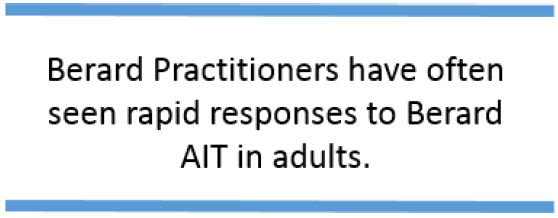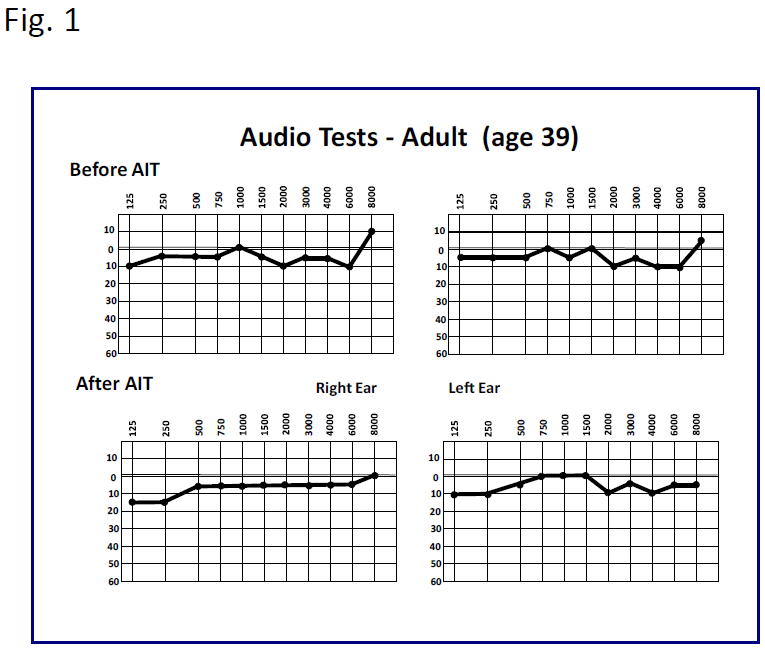By Sally Brockett, M.S., Director, IDEA Training Center
Adults become interested in Berard AIT for a variety of reasons. They may have heard about it from family, or a friend or colleague, or they may have pursued it for their children. Adults working in diverse occupations, such as business, entertainment, education, sports, healthcare, etc., may discover the Berard method when in the process of seeking techniques for selfimprovement. Some of the areas of change that might benefit adults include: memory, selfconfidence, organization, speech and language, public speaking, reading and writing skills, sense of well-being, concentration, and attention.
Berard AIT Practitioners also report the common experience of parents stating that they have learned through their child’s struggles with behavior and learning challenges that they too, have the same or similar difficulties. They do not want their child to face the same discouraging experiences that they did. The parents report that if the diagnostic labels in current use had been available when they were in school years ago, they would also have been identified with special needs, and would have received special support services through the school district. Since the educational system was different at that time, these parents struggled, often without support, and developed the belief that they were just poor students or slow learners, or simply did not have the concentration needed for success in school. As they matured, they had to compensate for their specific areas of difficulty, or chose careers that were not demanding in the areas where they were more challenged. However, as they seek assistance for their child, they now see themselves in their child’s struggle.
 Therefore, Berard AIT Practitioners are often asked whether Berard AIT works for adults. The answer is yes! Brain research has demonstrated that neural plasticity, the ability of the brain to reorganize itself so new neural connections can perform work that was originally assigned to other connections, functions until death. Neural plasticity may be utilized more quickly in the younger child’s brain which is undergoing growth and development at a faster rate, however, Berard Practitioners have often seen rapid responses to Berard AIT in adults. There are young children who show a quick response to Berard AIT, while others may make a gradual improvement over the months following training. We see this pattern in both adults and children.
Therefore, Berard AIT Practitioners are often asked whether Berard AIT works for adults. The answer is yes! Brain research has demonstrated that neural plasticity, the ability of the brain to reorganize itself so new neural connections can perform work that was originally assigned to other connections, functions until death. Neural plasticity may be utilized more quickly in the younger child’s brain which is undergoing growth and development at a faster rate, however, Berard Practitioners have often seen rapid responses to Berard AIT in adults. There are young children who show a quick response to Berard AIT, while others may make a gradual improvement over the months following training. We see this pattern in both adults and children.
The fact that Berard AIT can result in improvements in adults has been demonstrated not only through personal reports, but through pre and post testing on the audio test (see Figure 1) and in pre and post standardized tests (see Figure 2).

The desired audio test pattern is a relatively flat line across the frequencies. The flat line
indicates that the listener hears each frequency at approximately the same level of
loudness. When there are peaks and valleys in the pattern, the listener is hearing some
frequencies with more or less acuity than the neighboring frequencies. This may cause
distortions in the message being received. The test is done prior to starting the AIT
program, and is repeated after the first 5 hours of listening, and again at the end of 10
hours of listening. The audio test pattern generally continues to flatten in the coming
months and is often flatter at the end of 3 months post-AIT. In Figure 1 above, the right
ear pattern is already flat, and the left ear pattern shows improvement, with only 1 peak
remaining.

The SCAN-A is a standardized screening test for identifying individuals who may have
auditory processing disorders. Percentiles below 25 are 1 or more standard deviations
below the mean, indicating borderline or disordered auditory processing skills.
The next question that is often asked is what types of changes might the adult experience? Adults who have participated in Berard AIT report the same types of responses as those seen in children. This may include improvements in auditory figure-ground discrimination (the ability to block out distracting background noise), auditory perception and discrimination, auditory memory, word finding (the ability to recall a specific word or name), auditory and sensory processing, verbal and written language, reading speed and comprehension, organization, self-confidence, calmness, socialization, etc. Just as with children, it is not possible to specify exactly where the changes will occur in adults.
 Adults who have completed Berard AIT often comment on the changes it has made in their lives. One woman exclaimed how she wished this had been available to her as a child. Another adult went on to college and became an occupational therapy assistant, something she would never have had the confidence to do prior to her experience with Berard AIT. So, while it is more frequently used with children, it is certainly available and recommended for adults as well. It is never too late to open new doors to life experiences!
Adults who have completed Berard AIT often comment on the changes it has made in their lives. One woman exclaimed how she wished this had been available to her as a child. Another adult went on to college and became an occupational therapy assistant, something she would never have had the confidence to do prior to her experience with Berard AIT. So, while it is more frequently used with children, it is certainly available and recommended for adults as well. It is never too late to open new doors to life experiences!